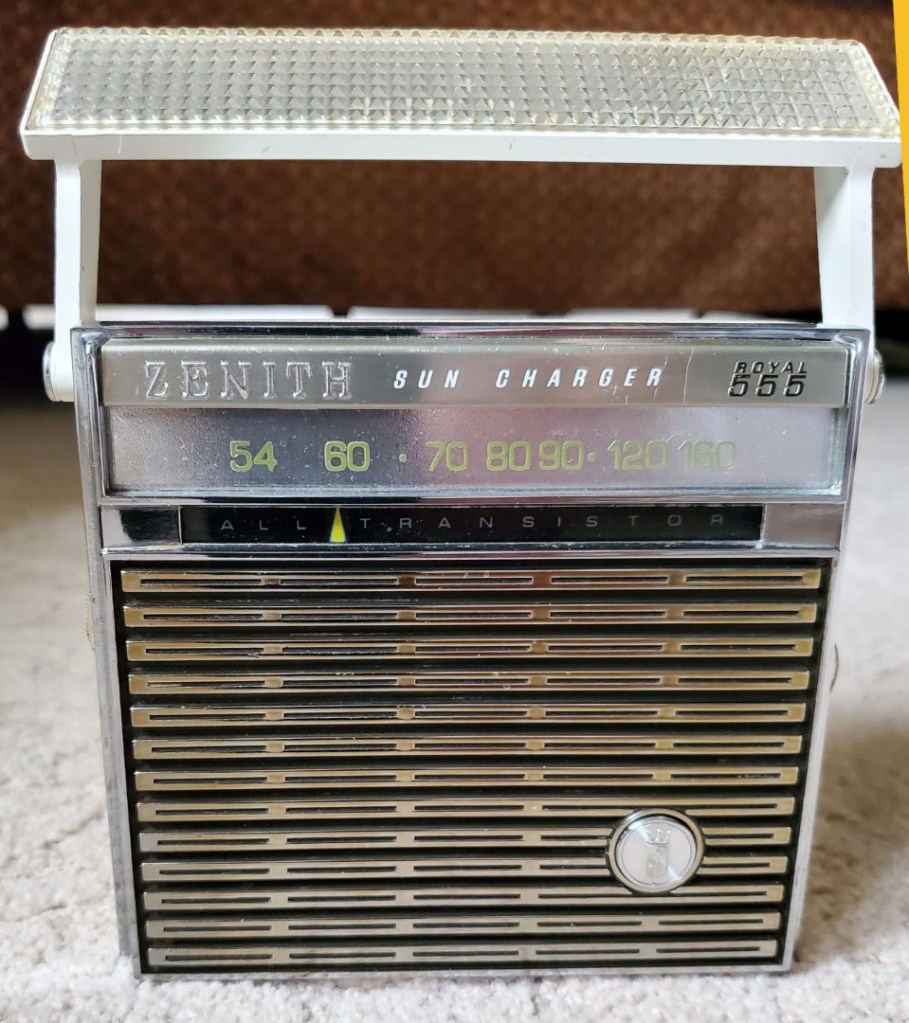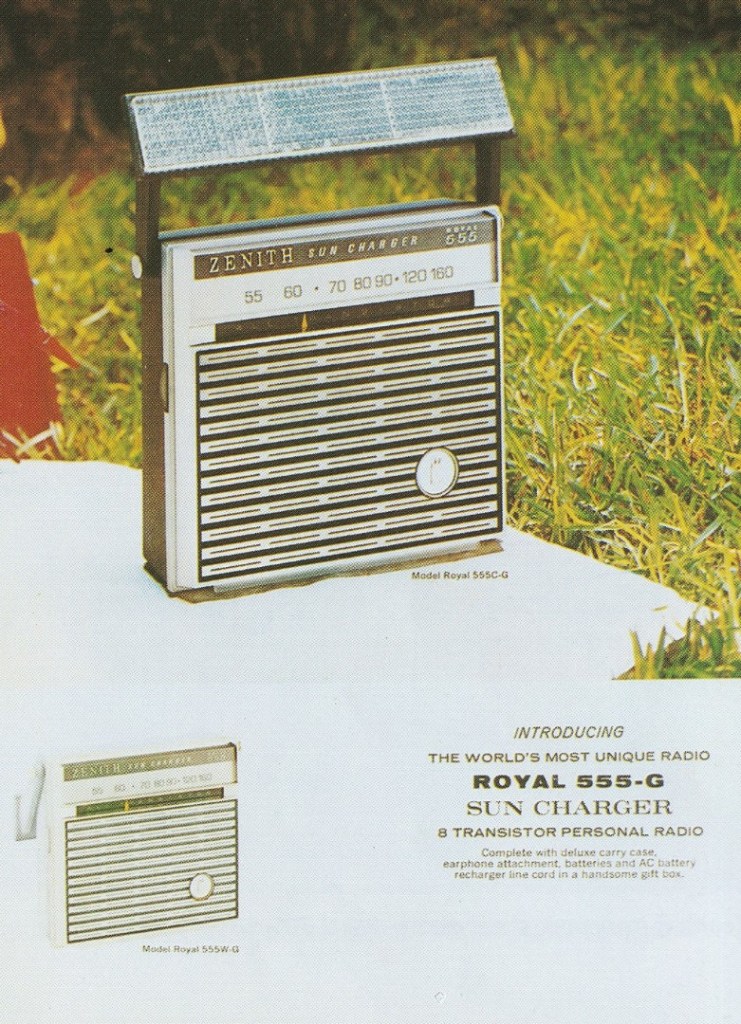Zenith Royal 500N-G/Royal 555G Suncharger AM Radios

The Zenith Royal 500N-G/Royal 555G were introduced in 1965 and were available in White or Charcoal. In their literature these colors were identified as models 500W-NG/500C-NG and the 555C-G and 555W-G. For simplicity I will refer to their simplified model names in this article. They were the last of the famed Royal 500 line, one of the most iconic lines of its day. They were later rebadged as the Royal 41 and Royal 56 to freshen their names but they used the same circuits and were therefore identical in everything but their model numbers. This renaming is something Zenith did with some of their other models in the mid to later 60’s when new product introductions were expected each year. Other examples of this include the renaming of their Royal 755M as the Royal 74 and their Super Navigator Royal 790YM as the Royal 97. Sometimes there were minor circuit changes, but usually these were only made to make use of more readily available components with similar characteristics…often different transistors for example.
(For an article on the other models in the Royal 500 series see here).

Description: The 500N and 555 were identical radios with the only differences being the Surcharger features on the Royal 555. In a nutshell:
The Royal 500N ran on 4 standard AA cells or an external AC power supply.
The Royal 555 ran on 4 NiCad AA cells and contained a built-in AC power supply which could run the radio directly or recharge the batteries.
The flip up handle of the 500N was replaced by a larger flip up handle on the 555 which contained the solar cells…Zenith referred to it as the “Miracle Sunray Handle”. The Royal 555 Suncharger retailed for $59.95…I couldn’t find pricing info for the 500N but given the fact that the earlier 500H-1 and 500L sold for $39.95 that is a good guess.
As far as I can tell the only additional circuit differences are two resistors associated with the output transistors which compensate for the slightly reduced voltage of NiCad cells compared with standard AA cells – nominally 1.25 volts versus 1.5 volts although the modern Nicad’s I have measure about 1.3 volts. What this means is that the two radios perform virtually identically.

I read an intriguing report years ago that these solar panels were sourced from NASA as part of their solar development program, either being excess or not meeting their specific requirements. I can’t find that info today and can’t represent that it is accurate, but it sure is a great story!
These sets were specified to cover AM from 540 – 1600 KHz but the alignment instructions call for it to be set to top out at 1620 KHz.
Size: 5.5 in H x 7.25 in W x 3.5 In L
As the last of the Royal 500 series these two were once again a complete redesign from the earlier models. Like the predecessor Royal 500H this is an 8 transistor circuit with an untuned RF amp, separate mixer and oscillator transistors and an air-variable tuning gang. The wider case allows the use of a 5” ferrite rod of good cross section and there is an easy-to-read long dial scale with bright push button illumination.

In Use: There are no big surprises here. These are AM-only portables with only basic controls. On the left side is the On/Off/Volume thumbwheel. On the right is the Tuning thumbwheel. On the front is a momentary pushbutton for the dial light and on the back there is a headphone jack and either a DC input jack for the ‘500N or an AC input socket for the ‘555. A nice feature of the 555 is that the solar panel can be tilted to take best advantage of the sun’s angle…a feature none of my other solar charging radios offer.

Reception and sound are good even if not the equal of the Royal 500H, which is indisputably the pinnacle of the Royal 500 line. Side by side their weak signal sensitivity is not night and day different but the 500H can maintain higher volume on very weak signals, while medium strength signals show less of a difference…the 500N/555 are fine for typical listening.
There is a bigger difference in sound quality. Although the newer models sound fine on their own, when compared side by side the 500H sounds nicer with a smoother, wider frequency response due in part to its larger speaker and more powerful amplifier as opposed to the decidedly more midrangy sound of the 500N/555.

Running the 555 on AC Power: The 555 Suncharger has a built-in AC power supply which can recharge the internal batteries or run the battery directly but it must be noted that when running on AC power you must have the NiCad batteries installed or there will be hum. This is because the batteries act as a capacitor across the power supply to filter hum. This does not pertain to the 500N which can run on its external power supply with no batteries installed. At least one intrepid modder has installed a 100uf 35 volt electrolytic capacitor across the rectifier to allow AC operation with no batteries installed but IMHO I think most users will prefer to use the radio as designed with NiCad batteries installed as the solar charging function is the major attraction of this radio.

I also found that the solar panel is capable of fully charging NiCad batteries in a day so if you have a handy window that provides good sun you may never have to manually charge the batteries. (Zenith’s Service information specifies their original NiCads at 450 mAh capacity but some modern Nicads can be more than double that value so proportionally longer charge times would be needed for a full charge and playing time will be longer as well.) Also note that the use of other than NiCad batteries, such a NIMH is not recommended and may not result in full charging as their voltage/current requirement is different than for NiCads.

Conclusion: The Royal 500N/555G mark a mixed end to Zenith’s very successful Royal 500 series. From its inception with the pioneering original “Owl Eye” Royal 500 through the ever-improving updated models 500B, C, D, E and H, the Zenith 500’s lead the way in quality and performance. There was no doubt that a Zenith was one of the best radios you could buy, but they eventually succumbed to price pressure from much less expensive Japanese imports and began to downgrade some of their models such as the Royal 500 E-1, H-1 and L which were all cost-reduced designs. These final Royals, the 500N and 555 Suncharger were not as well designed as the 500H but the 555 is unique in this line due to its solar charging feature which to me is a great novelty and I do like its lighted slide rule dial. It’s a shame that the last 500 should be a step back from earlier models while it offered an amazing advancement for its day, and for that reason alone I’m glad to add it to my collection.
You must be logged in to post a comment.